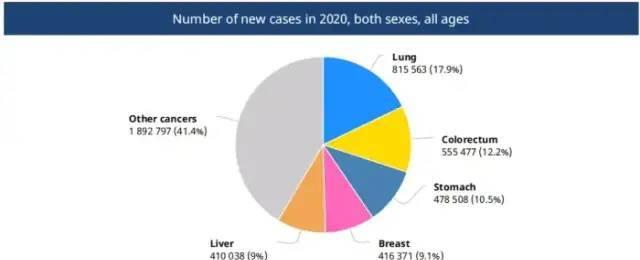Modern medicine generally believes that the vast majority of diseases, including cancer, follow this law of development.
Risk factors continue to act, leading to damage to target cells, target tissues, target organs, and when these damages accumulate or the body's repair or self-healing power fails to repair enough to maintain a sufficient number of quality tissues, it can lead to symptoms and even acute events, and finally lead to death.
It is not difficult to see that the risk factor is the initiator. It's not that avoiding risk factors is necessarily avoiding disease (a truly risk-free way of living doesn't exist), but that by staying away from risk factors, we can greatly reduce the risk of getting sick, especially for age-related diseases such as cancer, cardiovascular disease, diabetes, and metabolic syndrome, which all have an important feature - continuous stress or damage over the years.
According to the global cancer data released by the World Health Organization in 2021, the total number of new cancers in China in 2020 was 4,568,754, and the number of deaths due to cancer was 3,002,899.

The World Health Organization's International Agency for Research on Cancer released the Global Cancer Report in 2021, which lists the identified carcinogens for different cancers. Check it out!
NO.1 Lung cancer
In 2020, there were 815,563 new cases in China, accounting for 17.9% of the total number of new cancers.
Risk factors include (in alphabetical order):
NO.2 Colorectal cancer
555,477 new cases were added in China in 2020, accounting for 12.2% of all new cancers
NO.3 Stomach cancer
478,505 new cases in China in 2020, accounting for 10.5% of all new cancers
NO.4 Breast cancer
In 2020, there were 416,371 new cases in China, accounting for 9.1% of all new cancers (men can also get breast cancer!). )
NO.5 Liver cancer
410,038 new cases in China in 2020, accounting for 9% of all new cancers
NO.6 Esophageal cancer
324,422 new cases in China in 2020, accounting for 7.1% of all new cancers
NO.7 Thyroid cancer
In 2020, there were 221,093 new cases in China, accounting for 4.8% of all new cancers.
NO.8 Leukemia (including lymphoma)
178,238 new cases were added in China in 2020, accounting for 3.9% of all new cancers
NO.9 Pancreatic cancer
124,994 new cases were added in China in 2020, accounting for 2.7% of all new cancers
NO.10 Prostate cancer
115,426 new cases in China in 2020, accounting for 2.5% of all new cancers
No substances have been specifically associated with prostate cancer development, but exposure to or accidental ingestion of 2,3,7,8-tetrachlorodibenzo-p-dioxin (2,3,7,8-Tetrachlorodibenzo-para-dioxin) increases the risk of cancer in all organs of the body.
NO.11 Cervical cancer
109,741 new cases were added in China in 2020, accounting for 2.4% of all new cancers
NO.12 Bladder cancer
85,694 new cases in China in 2020, accounting for 1.9% of all new cancers
NO.13 Uterine cancer
81,964 new cases in China in 2020, accounting for 1.8% of all new cancers
NO.14 Cancers of the central nervous system
79,575 new cases in China in 2020, accounting for 1.7% of all new cancers
Only one clear risk factor has been identified, and that is X-radiation, γ-radiation (X-radiation, γ-radiation).
NO. 15 Kidney cancer
73,587 new cases in China in 2020, accounting for 1.6% of all new cancers
NO. 16 Nasopharyngeal carcinoma
62,444 new cases were added in China in 2020, accounting for 1.4% of all new cancers.
NO. 17 Ovarian cancer
55,342 new cases were added in China in 2020, accounting for 1.2% of all new cancers
NO. 18 Oral cancer (including lip cancer)
30,117 new cases in China in 2020, accounting for 0.66% of all new cancers
NO. 19 Laryngeal cancer
29,135 new cases in China in 2020, accounting for 0.64% of all new cancers
NO. 20 Gallbladder cancer
In 2020, there were 28,923 new cases in China, accounting for 0.63% of all new cancers.
Only one risk factor has been identified so far, and that is thorium-232 and its decay products.
Quickly collect it and forward it to friends who pay attention to health and cancer prevention!
bibliography:
Wild CP, Weiderpass E, Stewart BW. World Cancer Report: Cancer Research for Cancer Prevention World Cancer Reports.2021